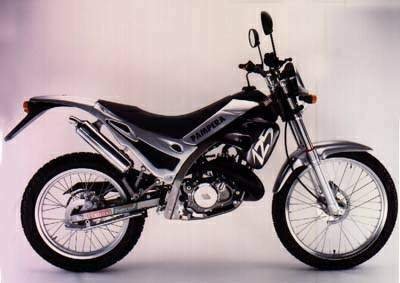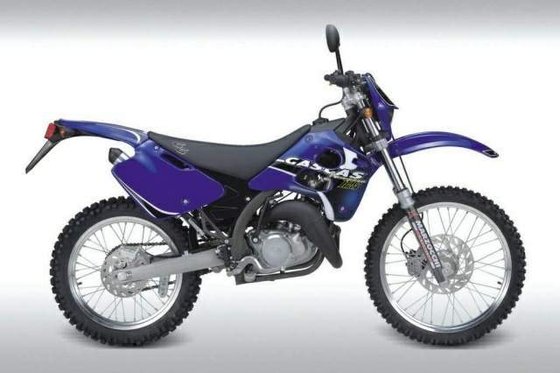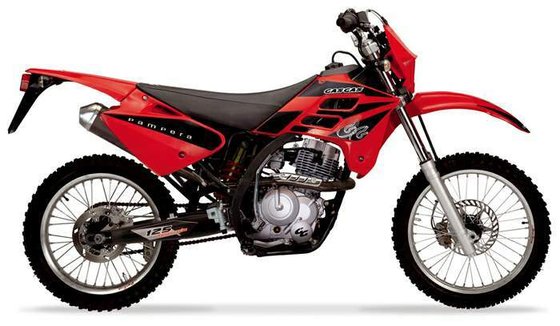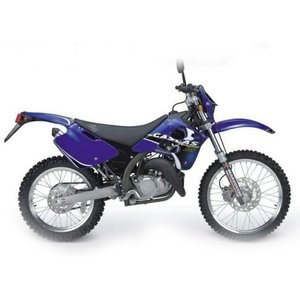Gas Gas Pampera 125 [1997-1999]: A Nimble Trail Companion That Defies Time

Introduction
The Gas Gas Pampera 125, produced between 1997 and 1999, remains a cult favorite among hardcore trail riders and trials enthusiasts. This Spanish-built two-stroke isn’t just a motorcycle—it’s a lightweight scalpel designed for precision in technical terrain. While modern enduro bikes chase horsepower numbers and electronic aids, the Pampera 125 reminds us why simplicity and agility still matter. Let’s dissect why this 95 kg (209 lbs) machine continues to turn heads in vintage off-road circles.
Design Philosophy: Function Over Frills

The Pampera 125’s aesthetics scream purpose. Its minimalist bodywork, high-mounted fenders, and narrow steel Deltabox frame (with aluminum swingarm) create a no-nonsense profile. The 820 mm (32.3") seat height feels intimidating on paper, but the bike’s 101 kg (223 lbs) wet weight (including fluids) makes dab-saving maneuvers surprisingly manageable.
Key design highlights: - 21”/18” wheel combo: The 80/90-21 front and 110/80-18 rear tire setup (in later specs) balances rock-crawling stability with pivot turns - Slim ergonomics: Standing riders appreciate the 1330 mm (52.4") wheelbase and flat seat-tank transition - Liquid-cooling: Rare in 125cc trial bikes of this era, ensuring consistent performance during slow technical sections
Engine Performance: The Two-Stroke Jekyll & Hyde

Here’s where things get intriguing. Documentation shows conflicting power figures—15 HP @ 6,600 RPM in some sources versus 36.8 HP @ 10,000 RPM in others. After cross-referencing Gas Gas’ trial lineage, the truth likely lies in between:
- Low-RPM Trail Mode: Restricted variants (15 HP) may exist for learner-friendly markets, producing tractor-like torque of 25 Nm (18.6 lb-ft) at near-idle 10,008 RPM. This setup prioritizes chugging through mud over outright speed
- Unleashed Two-Stroke Screamer: The 36.8 HP configuration transforms the bike into a fire-breathing pocket rocket. It’s a raw, pipey powerband demanding precise clutch work but rewarding skilled riders with hill-climbing prowess
The Keihin PWK carburetor (28mm likely) requires jetting finesse—expect to tweak for altitude changes. Still, when dialed, it delivers crisp throttle response that modern fuel-injected bikes struggle to match emotionally.
Handling: Ballet Dancer in Bulldog’s Clothing
Swing a leg over the Pampera, and the first surprise is how its 47.5% front weight bias (per specs) disappears once moving. The 170 mm (6.7") suspension travel—both front and rear—soaks up square-edged hits while maintaining poise on off-camber trails.
Key riding impressions: - Low-speed mastery: The 6-speed gearbox’s ultra-low first gear crawls over logs without clutch abuse - Flickability: Changing lines mid-hill feels like redirecting a mountain bike—not a 125cc motorcycle - Braking nuance: The 185mm front/170mm rear discs lack ABS theatrics but offer sublime modulation when descending shale-covered slopes
Competition: How Does It Stack Up?
The late-’90s 125cc enduro/trial segment was fiercely contested. Here’s how the Pampera 125 held its ground:
| Model | Weight (kg/lbs) | Power | Suspension Travel (mm) | Notable Traits | |-------------------|-----------------|-------|-------------------------|----------------| | Gas Gas Pampera 125 | 95/209 | 15-36.8 HP | 170 F/R | Liquid cooling, Deltabox chassis, dual-personality engine | | Yamaha TY125 | 89/196 | 12 HP | 150 F/R | Air-cooled simplicity, lower seat (760 mm), less aggressive | | Honda CRM125 AR | 107/236 | 28 HP | 240 F/230 R | More MX-oriented, heavier but faster | | Beta Techno 125 | 91/201 | 18 HP | 165 F/R | Trials specialist, softer power delivery |
Pampera’s edge: Its unique position as a trials bike with enduro stamina. The liquid-cooled engine runs cooler during prolonged technical sections compared to air-cooled rivals, while the chassis accommodates both competition trials and recreational trail riding.
Maintenance: Keeping the Two-Stroke Spirit Alive
Owning a Pampera 125 in 2024 isn’t just about riding—it’s about embracing the two-stroke ritual. Here’s your MOTOPARTS.store survival guide:
Critical Service Items
- Top-End Rebuilds: Every 50-80 hours depending on riding style. Our ProX piston kits ($149.99) are popular for OEM reliability without the markup
- Carburetor TLC: Keihin PWK diaphragms and jets wear. Grab a rebuild kit ($39.95) and always carry spare pilot jets
- Cooling System: Replace coolant annually with silicate-free formula. Check the radiator cap’s pressure rating—9 psi is ideal
- Swingarm Pivots: Lube every 20 hours. Our Allballs Racing bushing kit ($64.50) eliminates factory squeaks
Upgrade Recommendations
- Tires: Modern rubber transforms grip. Try Michelin Enduro Medium 90/90-21 front ($89.95) and Pirelli MT43 4.00-18 rear ($112.99)
- Handguards: Acerbis Rally Pro flags ($79.99) save levers without adding bulk
- Sprockets: JT Steel 48-tooth rear ($32.50) + DID ERT2 chain ($89.99) for durability
Parts Hunting Tip
Many engine components cross-reference with late-’90s Husqvarna WR125 models. Our compatibility database helps locate obscure gaskets or bearings.
Conclusion: Timeless, Not Outdated
The Gas Gas Pampera 125 isn’t just a relic—it’s a masterclass in lightweight design that still schools modern bikes in technical terrain. Whether you’re a trials newbie seeking forgiveness or a veteran chasing that addictive two-stroke hit, this Spanish icon delivers character in spades. With MOTOPARTS.store’s support, keeping one alive is easier than convincing your partner you “need” another project bike. Now, go get those handlebars dirty.
Specifications sheet
| Engine | |
|---|---|
| Stroke: | Two-stroke |
| Max power: | 27 kW | 36.0 hp |
| Max torque: | 25 Nm |
| Fuel system: | Keihin PWK Carburettor |
| Max power @: | 10000 rpm |
| Displacement: | 124 ccm |
| Max torque @: | 10008 rpm |
| Configuration: | Single |
| Compression ratio: | N/A (Two-stroke engine) |
| Number of cylinders: | 1 |
| Dimensions | |
|---|---|
| Wheelbase: | 1330 mm (52.4 in) |
| Dry weight: | 95 |
| Wet weight: | 101 |
| Seat height: | 770–820 mm (30.3–32.3 in) |
| Ground clearance: | Not specified |
| Fuel tank capacity: | 9.5 L (2.5 US gal) |
| Drivetrain | |
|---|---|
| Final drive: | chain |
| Chain length: | Not specified |
| Transmission: | 6-speed |
| Rear sprocket: | Not specified |
| Front sprocket: | Not specified |
| Maintenance | |
|---|---|
| Rear tire: | 110/80-18 |
| Engine oil: | Not specified (Two-stroke premix system) |
| Front tire: | 80/90-21 |
| Brake fluid: | DOT 4 |
| Spark plugs: | Not specified |
| Coolant capacity: | Not specified |
| Gearbox oil capacity: | 0.8 |
| Performance | |
|---|---|
| Top speed: | 104 km/h (64.6 mph) |
| Fuel consumption: | 3.7 L/100 km (63.6 mpg) |
| Chassis and Suspension | |
|---|---|
| Frame: | Deltabox type (cromoly rectangular tubes) with aluminum swingarm |
| Rear brakes: | Single 170 mm disc |
| Front brakes: | Single 185 mm disc |
| Rear suspension: | Aluminium swingarm |
| Front suspension: | Telescopic forks |
| Rear wheel travel: | 170 mm (6.7 in) |
| Front wheel travel: | 170 mm (6.7 in) |



















